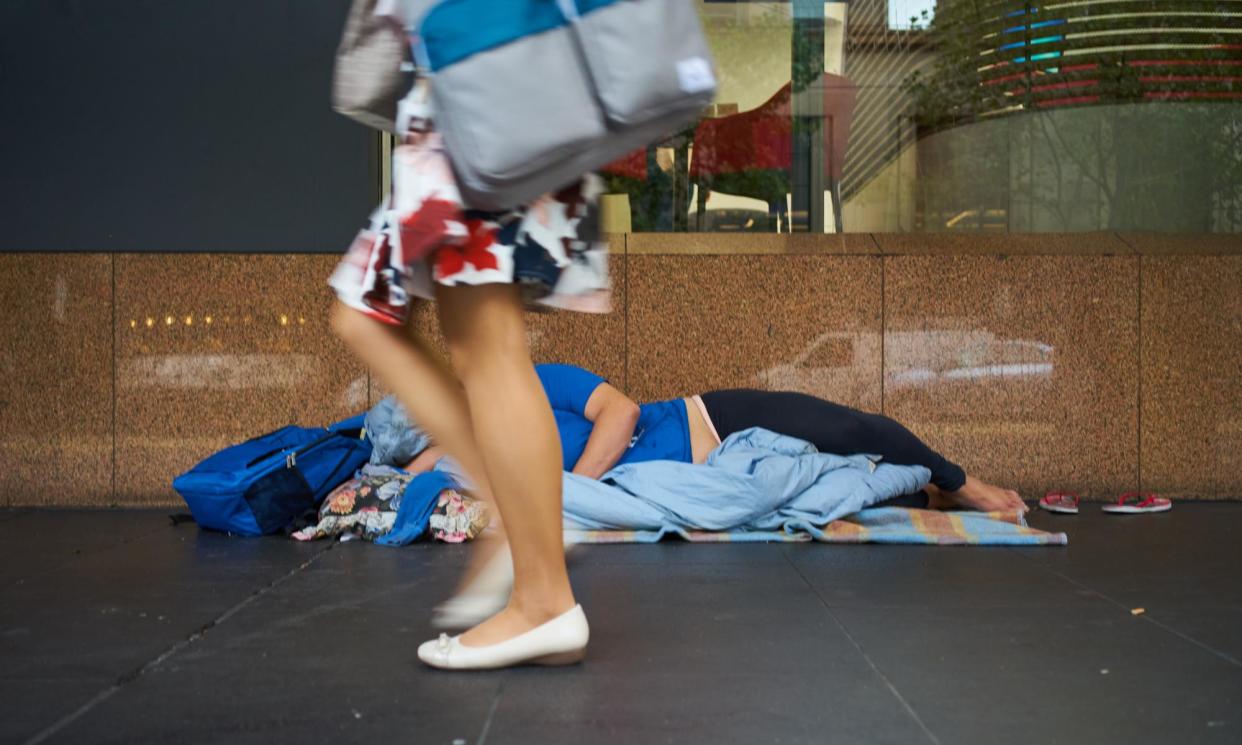‘Finding it impossible’: homelessness services see 14% jump in employed Victorians seeking help

The number of working Victorians seeking support from homelessness services has grown by 14% in the past two years, a new report has shown, with women disproportionately affected.
The report by the Council to Homeless Persons, released on Tuesday, showed an increase in the number of employed people seeking support across 61 of Victoria’s 80 local government areas (LGA).
Two of outer Melbourne’s growing LGAs – Casey and Wyndham – recorded the highest demand for services for those either experiencing homelessness or who were at risk of homelessness.
Related: Rough sleepers dying ‘alarmingly’ premature deaths, Sydney homeless data shows
In total, 12,150 employed people sought homelessness assistance in 2022-23, an increase of 14% since 2020-21, according to the report, which used data provided by the Australian Institute of Health and Welfare.
The council’s chief executive, Deborah Di Natale, said employed people now made up one in eight Victorians who were accessing support from homelessness services.
“People think that having a job is actually a protective barrier to homelessness and we now know – the data is telling us – that’s not true,” Di Natale said.
“More people than ever before in Victoria who are employed are seeking support of homelessness services.”
Di Natale said Melbourne’s outer suburbs and the state’s regional centres saw the highest jump.
About 40km south-east of Melbourne’s CBD, the Casey LGA is the fastest-growing municipality in the state and takes in suburbs such as Berwick, Cranbourne, Hampton Park and Narre Warren. In 2022-23, 641 employed people in Casey reached out to homelessness services for support, with 502 – or 78% – being women.
It was followed by Wyndham – in Melbourne’s south-west – and Greater Geelong, where 624 and 535 employed people sought support, respectively.
The report credited the rise in demand for homelessness services to the dual housing and cost-of-living crises.
“After hitting a record high a year ago, Victoria’s rents have since grown another 15%. People already finding it tough to pay the rent are now finding it impossible,” it said.
“Under-pressure homelessness services are seeing an alarming rise in new clients who have never struggled in the past.”
Overall, women accounted for more than 70% of working people seeking assistance.
Di Natale attributed this to the high proportion of women who work part-time or casually while juggling caring responsibilities. She also noted family violence was the leading cause of homelessness for women and children.
“Employed women escaping family violence are often faced with the impossible choice between shelter and abuse,” she said.
Christie, who asked for her surname not to be used, said she was forced to couch-surf for several years after she split from her partner about a decade ago.
“I had one fight too many and decided to leave,” she said.
At the time, she was working part-time as a primary school teacher while caring for her ill father and was unable to find an affordable place for her and her seven-year-old daughter to move into.
“Working part-time because I was a carer certainly didn’t help in trying to find a rental that I could afford,” she said.
It only got harder when her father got sicker and she had to stop working altogether. They now live with her mother in a rental provided by relatives.
“If we had a rent increase that people are going through right now, it [would be] really quite difficult for us,” Christie said.
The Council to Homeless Persons is calling on the state government to use the upcoming May budget to invest $23.4m over four years into the Private Rental Assistance Program, which provides financial assistance to maintain a tenancy and help people at risk of homelessness to avoid eviction.
The program also helps quickly rehouse people who have been evicted.
Two state parliamentary inquiries – one into homelessness and another into the housing and rental crisis – have recommended increasing funding for the project to ensure those most at risk don’t slip into homelessness.
The latter, which tabled its final report in late 2023, noted no further funding had been provided for the Private Rental Assistance Program since the $110m committed at the 2021–22 state budget.


